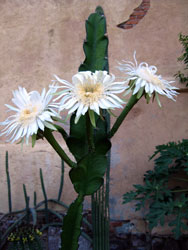Resource Library
Plant of the Week: Night Blooming Cereus
The University of Arkansas System Division of Agriculture does not promote, support or recommend plants featured in "Plant of the Week." Please consult your local Extension office for plants suitable for your region.
Plant of the Week
Night Blooming Cereus

The night blooming cereus started blooming in the greenhouse in mid-September and, though I wasn’t there to watch it open, I was able to enjoy the blooms early the next morning. In the thrall of the plant’s beauty, I began to try to give the plant a proper Latin name based on its common name. Though this task should be simple, I quickly learned otherwise.
The name night blooming cereus is used interchangeably for at least four night blooming cacti: Hydrocereus undatus, Epiphyllum oxypetalum, Peniocereus greggii and Selenicereus grandiflorus. Each of these species has an “approved” common name but to the uninitiated, if it is an ugly, sprawling cactus with large, magnificent flowers that appear at night, it is called night blooming cereus. Though the blooms have a similar appearance, the plant form of the four species is remarkably different.
All of these cacti share a large, creamy-white flower up to 6 inches across with numerous petals. Each flower is produced atop a long tube that may be curved or straight, but is usually about six inches long. In the center of the petals are numerous yellow stamens. The flowers open at dusk, and wither within an hour or so after sunrise. In their native habitat, these species are pollinated by nectar-feeding bats. Blooming is during the mid-to-late summer for most species.
Hydrocereus undatus, perhaps best called Red Pitaya or Dragonfruit, is a sprawling, freely rooting cactus of Mexico and Central America with stout, triangular stems to 1 ½ inches across. The stems are round-lobed, spineless and sparsely branched. This species is grown in tropical countries for its fist-sized red fruit which, when cut open, is white with a random scattering of small black seeds.
Epiphyllum oxypetalum, also called Dutchman’s Pipe cactus because of its curved tube, is perhaps the most commonly seen of the “night blooming cereus” cacti because it blooms better in smaller pots and makes a somewhat more attractive houseplant when not in bloom. It is a true epiphyte that can be found in the forest canopy from southern Mexico through Central America to Brazil. The cultivated form is apparently a hybrid, something that has been going on in Europe since the late 1700s when the plants were first introduced there. At its base, the plant has round, spineless stems that flatten out to round-lobed, spineless branches. The blossoms are produced from the notches along the flat, spatula-like portion of the stem.
Peniocereus greggii and Selenicereus grandiflorus probably have more right to claim the name of “cereus” than the other two species, for they are both armed with slender thorns. Peniocereus is native to the deserts of southern Arizona and northern Mexico. It has rounded stems - a sprawling habit designed to rest on neighboring plants. It produces a large tuber and was used as a food source by Native Americans. Selenicereus is similar in appearance with a similar growth form, but lacks the tuber.
Night blooming cereus, regardless of the species being grown, are large plants that should have at least a 10-inch pot. They may be slow to bloom, with first flowers often not appearing for three to five years after the plants are propagated. Because the plants are so inherently ugly, many gardeners have trouble getting past this adolescent stage to be able to enjoy the blooms. Once plants attain blooming size, don’t be in a hurry to repot, for blooms are usually better in stressed, root-bound plants.
Plants should have a bright position during the summer months, but some shade during the hottest part of the day will keep the foliage looking better. Too much shade is a common cause for failure to flower. As long as the potting medium is well drained it will be hard to overwater them but, being cacti, they can tolerate periods of neglect. Once the buds begin forming, don’t let the plants dry out. Like any cacti, they are light feeders, so fertilize less than you would normally do with leafy houseplants. In the winter, give the plant a bright position but cut back on watering and allow the plant to go into a state of semi-dormancy.
By: Gerald Klingaman, retired
Extension Horticulturist - Ornamentals
Extension News - October 1, 2010
The University of Arkansas System Division of Agriculture does not maintain lists of retail outlets where these plants can be purchased. Please check your local nursery or other retail outlets to ask about the availability of these plants for your growing area.